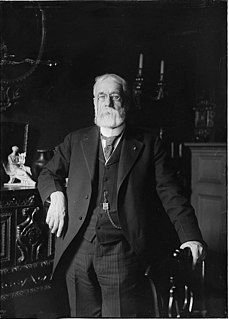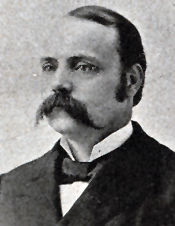
The Statute of Anne, also known as the Copyright Act 1710, is an act of the Parliament of Great Britain passed in 1710, which was the first statute to provide for copyright regulated by the government and courts, rather than by private parties.
Eldred v. Ashcroft, 537 U.S. 186 (2003), was a decision by the Supreme Court of the United States upholding the constitutionality of the 1998 Sonny Bono Copyright Term Extension Act (CTEA). The practical result of this was to prevent a number of works from entering the public domain in 1998 and following years, as would have occurred under the Copyright Act of 1976. Materials which the plaintiffs had worked with and were ready to republish were now unavailable due to copyright restrictions.

The 26th United States Congress was a meeting of the legislative branch of the United States federal government, consisting of the United States Senate and the United States House of Representatives. It met in Washington, D.C. from March 4, 1839, to March 4, 1841, during the third and fourth years of Martin Van Buren's presidency. The apportionment of seats in the House of Representatives was based on the Fifth Census of the United States in 1830. Both chambers had a Democratic majority.

The Copyright Act of 1790 was the first federal copyright act to be instituted in the United States, though most of the states had passed various legislation securing copyrights in the years immediately following the Revolutionary War. The stated object of the act was the "encouragement of learning," and it achieved this by securing authors the "sole right and liberty of printing, reprinting, publishing and vending" the copies of their "maps, charts, and books" for a term of 14 years, with the right to renew for one additional 14-year term should the copyright holder still be alive.
In public policy, a sunset provision or sunset clause is a measure within a statute, regulation or other law that provides that the law shall cease to have effect after a specific date, unless further legislative action is taken to extend the law. Most laws do not have sunset clauses and therefore remain in force indefinitely, except under systems in which desuetude applies.

The copyright law of Canada governs the legally enforceable rights to creative and artistic works under the laws of Canada. Canada passed its first colonial copyright statute in 1832 but was subject to imperial copyright law established by Britain until 1921. Current copyright law was established by the Copyright Act of Canada which was first passed in 1921 and substantially amended in 1988, 1997, and 2012. All powers to legislate copyright law are in the jurisdiction of the Parliament of Canada by virtue of section 91(23) of the Constitution Act, 1867.

The International Copyright Act of 1891 is the first U.S. congressional act that extended limited protection to foreign copyright holders from select nations. Formally known as the "International Copyright Act of 1891", but more commonly referred to as the "Chace Act" after Sen. Jonathan Chace of Rhode Island.

Robert Underwood Johnson was an American writer, poet, and diplomat.
The Manufacturing clause is a clause specifically stating that all copies of a work must be printed or otherwise produced domestically, even if the copyright was held by a foreigner. This was a feature of the International Copyright Act of 1891, covering books, maps, photographs, and lithographs. Its extension to all other media was proposed in the 1897 Treloar Copyright Bill, which failed in committee. The manufacturing clause did not expire until 1986, keeping the United States out of the Berne Convention until 1989.
The Design Piracy Prohibition Act, H.R. 2033, S. 1957, and H.R. 2196, were bills of the same name introduced in the United States Congress that would have amended Title 17 of the United States Code to provide sui generis protection to fashion designs for a period of three years. The Acts would have extend protection to "the appearance as a whole of an article of apparel, including its ornamentation," with "apparel" defined to include "men's, women's, or children's clothing, including undergarments, outerwear, gloves, footwear, and headgear;" "handbags, purses, and tote bags;" belts, and eyeglass frames. In order to receive the three-year term of protection, the designer would be required to register with the U.S. Copyright Office within three months of going public with the design.

William Mitchellson Treloar was an American music professor, composer, music publisher, and U.S. Representative from Missouri.
The Prioritizing Resources and Organization for Intellectual Property Act of 2008 is a United States law that increases both civil and criminal penalties for trademark, patent and copyright infringement. The law also establishes a new executive branch office, the Office of the United States Intellectual Property Enforcement Representative (USIPER).

The Copyright Term Extension Act (CTEA) of 1998 extended copyright terms in the United States. It is one of several acts extending the terms of copyrights.

The Copyright Clause describes an enumerated power listed in the United States Constitution.
Under the law of United Kingdom, a copyright is an intangible property right subsisting in certain qualifying subject-matter. Copyright law is governed by the Copyright, Designs and Patents Act 1988, as amended from time to time. As a result of increasing legal integration and harmonisation throughout the European Union a complete picture of the law can only be acquired through recourse to EU jurisprudence, although this is likely to change by the expiration of the Brexit transition period on 31 December 2020, the UK having left the EU on 31 January 2020. On 12 September 2018 the European Parliament approved new copyright rules to help secure the rights of writers and musicians.

The Copyright Act of 1976 is a United States copyright law and remains the primary basis of copyright law in the United States, as amended by several later enacted copyright provisions. The Act spells out the basic rights of copyright holders, codified the doctrine of "fair use", and for most new copyrights adopted a unitary term based on the date of the author's death rather than the prior scheme of fixed initial and renewal terms. It became Public Law number 94-553 on October 19, 1976 and went into effect on January 1, 1978.
The copyright law of the United States has a long and complicated history, dating back to colonial times. It was established as federal law with the Copyright Act of 1790. This act was updated many times, including a major revision in 1976.

The Copyright Act of 1870, also called the Patent Act of 1870 and the Trade Mark Act of 1870, was a revision to United States intellectual property law, covering copyrights and patents. Eight sections of the bill, sometimes called the Trade Mark Act of 1870, introduced trademarks to United States federal law, although that portion was later deemed unconstitutional after the Trade-Mark Cases.

The CLASSICS Act or Compensating Legacy Artists for their Songs, Service, and Important Contributions to Society Act (H.R.3301) is proposed legislation of the 115th United States Congress to amend title 17 of the United States Code, to provide Federal protection to the digital audio transmission of a sound recording fixed before February 15, 1972, and for other purposes.

The Orrin G. Hatch–Bob Goodlatte Music Modernization Act, or Music Modernization Act or MMA is United States legislation signed into law on October 11, 2018 aimed to modernize copyright-related issues for music and audio recordings due to new forms of technology such as digital streaming. It is a consolidation of three separate bills introduced during the 115th United States Congress.






